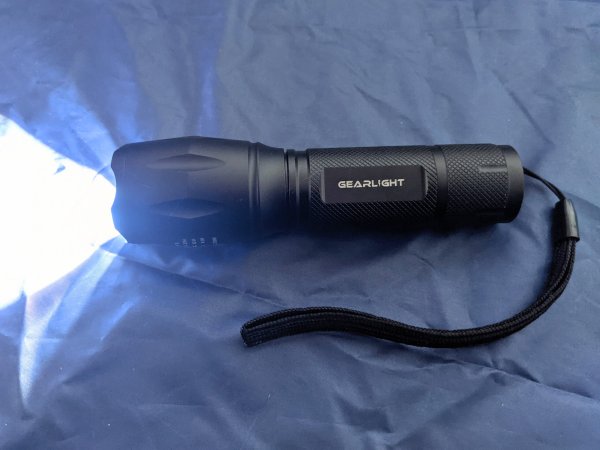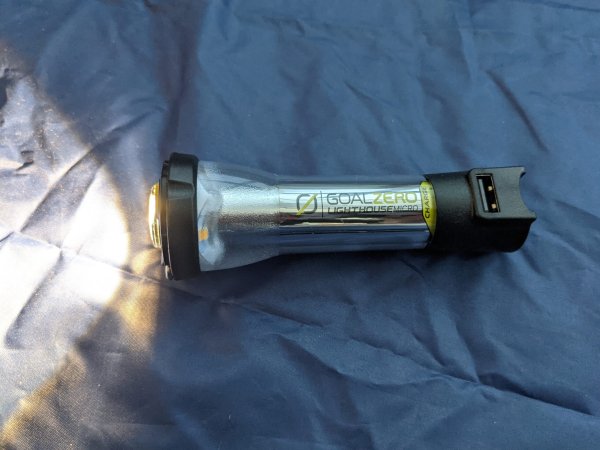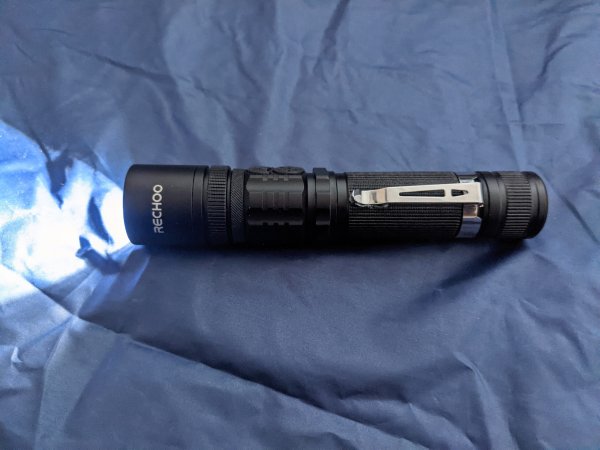We may earn revenue from the products available on this page and participate in affiliate programs. Learn More ›
No matter how many camping lanterns or headlamps you own, nothing will ever replace the importance of a flashlight in your camping setup. The ability to quickly grab and point a flashlight directly at your target—finding your tent as the last embers of your fire die down, rooting around in the car for your missing toothbrush—makes it an indispensable accessory. To help you choose the right model for your next outdoor adventure, we called in over a dozen models to compare side by side.
- Best Overall: Gear Light S1000 LED
- Best Small: Cyclops TF-150
- Best for your Keychain: Acebeam Pokelit AA
- Best Large: CMT Steelcore 1000
- Best for Backpacking: Goal Zero Lighthouse Micro Charge
- Best Value: Anker Bolder LC90
- Best Headlamp: Decathlon Forclaz HL 500 Rechargeable 200 Lumens
- Best Budget: Rechoo S3000L
How I Tested the Best Camping Flashlights

To test the best camping flashlights, I checked out various models, including all-caps Amazon brands and big names like Cyclops, Goal Zero, Cascade Mountain Tech, and Anker, among others. I then independently checked their weight and length before taking them out on a camping trip to use in the field. I also looked at each flashlight’s waterproof or water resistance rating, as well as other features that could be useful to campers, hunters, and overlanders. Finally, I considered price and whether each was an appropriate flashlight for children.
The Best Camping Flashlights: Reviews and Recommendations
Best Overall: Gear Light S1000 LED
Key Features
- Lumens: 1000
- Battery Requirements: 3 AAAs
- Weight: 5.6 ounces
- Waterproof rating: N/A
Pros
- Very affordable
- Ability to concentrate or expand the light direction
Cons
- Small children can easily find and use the strobe function
If you’re looking to buy some flashlights in bulk for the whole family, then the Gear Light S1000 LED is a great choice. It has plenty of light for walking back from a ranger talk or finding the bathroom in the dead of night, but isn’t so bright that it will wake up everyone in the campground. I also liked that it’s small enough for even young children to hold in their hands and operate but not so small that adults are likely to fumble with it or misplace it in the middle of the night. Finally, this was one of the most affordable flashlights I looked at for people purchasing in bulk.
My only complaint about the Gear Light S1000 LED is a complaint I had about many of the camping flashlights I looked at for this test: the strobe function. During a camping trip, I handed off several of the contenders for best camping flashlight to my smallest testers, a three-year-old and an eight-year-old. Both found the strobe functions within minutes and were ready to turn our campsite in the woods into a rave scene. The flashlights were quickly confiscated. If you’re camping with children, keep in mind that the now-standard strobe function on flashlights may ultimately be a deterrent from handing off one to a child for their personal use.
Best Small: Cyclops TF-150
Key Features
- Lumens: 1200
- Battery Requirements: 1 AA
- Weight: 6.6 ounces
- Waterproof Rating: IPX4
Pros
- Small packed size won’t take up space in your camping setup
- Simple battery requirement
- No strobe function
Cons
- Small size means it can be hard to find when you need it
If you’re camping with the family, chances are space is at a premium. And while my preference is for the big beefy flashlights that are seemingly impossible to lose, there are also times when I’d like to devote the space in my car to something else. The small but mighty Cyclops TF-150 is a great option for those moments. In addition to being small, it’s also very affordable and has a simple battery requirement: just one AA. Since that’s usually the only spare battery I can find around the house anyway, this is perfect for avoiding trips to the store.
It’s worth noting that this was one of the few flashlights in my test lacking a strobe function. It also only outputs 150 lumens, making it a great choice for anyone worried about the light sleeper in their tent.
If you’re prone to misplacing items, however, the small size of the Cyclops TF-150 may actually turn out to be a disadvantage in the middle of the night, when you’re searching for a flashlight without waking up your partner. Consider my best overall or large pick if that sounds like you.
Best for your Keychain: Acebeam Pokelit AA
Key Features
- Lumens: 600
- Battery Requirements: 1 AA
- Weight: 2.1 ounces
- Waterproof Rating: IP68
Pros
- Lightweight
- Very bright
- Comes with a rechargeable battery
- Very waterproof and dustproof
Cons
- Somewhat expensive
- Small enough to lose if you aren’t careful
While the low-key Cyclops TF-150 is small, the Acebeam Pokelit is small and light. And very bright. If you’re camping by yourself and want the security of an extra light source somewhere accessible (like your key ring), this is an excellent choice. I also liked how easy it was to toggle between the high and low light settings, which can be helpful if you are trying to keep a low profile in the backcountry. While it comes with a handle wrist loop, my preference with this light would be to add it to my keychain, so that I would have a backup light to grab in the event the batteries on my first flashlight go out.
Like the Cyclops TF-150, the Acebeam Pokelit has no strobe option. While this is a benefit in the event your kid grabs the flashlight, the price and size of this flashlight make it a less suitable family option than others on this list.
Best Large: CMT Steelcore 1000
Key Features
- Lumens: 1000
- Battery Requirements: 4 AAs
- Weight: 11 ounces
- Waterproof Rating: IPX8
Pros
- Big and beefy profile is difficult to lose
- The closest aesthetics to a traditional flashlight of anything I looked at
- Very waterproof
Cons
- Larger battery requirement than other flashlights in my test
- Difficult to operate one-handed
I can’t be the only one nostalgic for the colorful plastic-cased flashlights of yore, with their dull lights and hard-to-find D batteries. They had a satisfying hand feel, were easy to find in the tent, and were so, so simple: on and off, that’s it. No three different dimmer settings. No strobes. No lantern capabilities.
If you find yourself wishing for a simpler time, than the aesthetics of the CMT Steelcore 1000 will appeal to you. It’s big and beefy without being heavy—the kind of flashlight you’d stash next to your sleeping bag for easy access in the middle of the night. It’s also bright without being blinding, with a warmer light than other bright-white LED models I looked at. Finally, it was surprisingly affordable, and CMT makes a 650-lumen version of this flashlight that is only slightly smaller and at an even lower price point.
Best for Backpacking: Goal Zero Lighthouse Micro Charge
Key Features
- Lumens: 120
- Battery Requirement: Rechargeable
- Weight: 3.1 ounces
- Waterproof Rating: IPX6
Pros
- Lightweight
- Reasonably waterproof
- Can be used as a flashlight, lantern, or external battery
- Affordable
- Long lasting light
Cons
- Not very bright
Let’s start with the con of the Goal Zero Lighthouse: it’s not exceptionally bright. If you need to follow a blood trail or do some serious night hiking, you’d be better off with one of the best headlamps. But if you just want to grab an easy light source or go to the bathroom or find something on the inside of your tent, it’s plenty of light.

Even better, it can be used as a lantern to light up either the entire interior or, if you’re sharing with your partner, just your half while they get a little shut eye. That’s a lot of functionality for just over 3 ounces.

At 12 hours, this flashlight has one of the longest run times of anything I looked at—you could easily go your entire trip without recharging it. In fact, you could use it to power up some of your other devices, as the internal battery has enough juice to power up a phone about once.
Best Value: Anker Bolder LC90
Key Features
- Lumens: 900
- Battery Requirements: Rechargeable
- Weight: 8.1 ounces
- Waterproof Rating: IPX5
Pros
- Very bright
- Affordably priced
Cons
- Micro USB charging port
- Shorter battery life than others in my test
It makes sense that the best value camping flashlight is made by the same company that makes one of the best solar generators: Anker. This is a pretty basic flashlight. One click goes on, one click goes off. Holding down the power button sets it up to go through a series of various flashing patterns (try to avoid this). That’s it.
I liked that this one had both a very bright setting and a fairly dim setting that were easy to maintain once you had clicked your way through to them. It had a great hand feel, and while it warmed up noticeably on the highest setting, it was never uncomfortable. It’s also very reasonably priced. My only gripe is that it has a Micro USB charging port, an increasingly uncommon cord to have in your arsenal if you misplace the cord the flashlight comes with.
Best Budget: Rechoo S3000L
Key Features
- Lumens: 600
- Battery Requirements: Rechargeable
- Weight: 4.8 ounces
- Waterproof Rating: IP65
Pros
- Affordably priced
- Plenty bright enough for most purposes
- Easy to use
Cons
- Fewer features than other flashlights we looked at
If you’re looking for something simple and affordable as part of your emergency backup kit, the Rechoo S3000L is a great option. It was one of the most affordable rechargeable flashlights I found for testing, had plenty of lumens to light up my testing room, and was simple to use and recharge. It even uses the more common USB-C for recharging, which will make your life much easier when you need to find a spare cord during a blackout.
Campers should note that this flashlight is rated only to IP65 for water resistance. That means it’s fine to take out into a sprinkle when you need to hit the restroom, but if you leave it out overnight during a rainstorm, you may find that it stops working. I also noted during testing that this rechargeable flashlight heated up somewhat quickly.
Best Headlamp for Camping: Decathlon Forclaz HL 500 Rechargeable 200 Lumens
Key Features
- Lumens: 200
- Battery Requirements: Rechargeable
- Weight: 3.2 ounces
- Waterproof Rating: IPX5
Pros
- Affordably priced
- Simple button operation
Cons
- Not as bright as other options on this list
- Fewer features
There are several reasons why campers should consider snagging a headlamp in addition to one of the best camping flashlights. They allow you to handle various tasks hands-free. The beam travels wherever you look. And it’s harder to misplace something strapped to your head than held in your hand during a midnight bathroom break. But you also don’t need 1000 lumens to find the campground restroom, and the other campers would prefer you stuck with something dimmer, too (they are trying to sleep).
The Decathlon Forclaz HL 500 Rechargeable 200 Lumens is a great option for campers looking for a better lighting solution for the evening hours. It’s affordable, easy to recharge via USB-A, and with enough lumens to see to the edge of your campsite (without waking up your neighbors in the campsite over). I also appreciated that it uses a simple “+” and “-” system to power up and down, starting with a simple red light, before going up to 80 lumens, and then 200 lumens. That makes it a lot easier to get out of your tent without waking up the kids, and helps to extend the battery life as well.
How to Choose the Best Camping Flashlight
Lumens
While the temptation with flashlights is to go for the brightest option available, that’s not necessarily a great idea for a camping flashlight. In the best case scenario while camping, you’re sharing a tent with your partner or family—people you’d just as soon not wake up in the middle of the night when you need to hit the restroom; in the worst case scenario, you are in a packed campground, and you’ll set someone’s dog off by shining a too-bright flashlight at their tent.
Cost
Camping flashlights should be cost effective—this is not a gear item to splurge on (save that for the best camping cookware or the best camping stoves). You’ll also want to factor in the cost of any batteries or power banks depending on whether your camping flashlight is rechargeable or not.
Size
When you’re looking at a flashlight, you need to think about how you’ll carry it. Will this be used in a big family tent or as part of a backpacking kit? The answer to that question will tell you if you want a small, slim light for emergency use or a larger light that will be easy to find in the dark of your tent.
Camping Flashlights Battery Use
Flashlights can use standard AA or AAA batteries or more exotic power supplies like CR123A batteries. Rechargeable flashlights are also becoming more and more prevalent. My preference leans toward rechargeable flashlights to cut down on waste and cost, especially since I am more likely to bring along one of the best power banks for camping. Today’s rechargeable batteries are also very powerful. If you bring along a flashlight that uses a non-standard battery (like CR123A) be sure to have your own spare batteries on hand as the more exotic batteries may not be available locally.
Waterproof Rating for Camping Flashlights
The water and dust IP ratings provide consumers with test-based information on how well a product can withstand the elements. This rating includes a separate grade for both the dust resistance (first digit after the IP) and the water resistance (second digit after the IP). (An “X” in place of either of these ratings means that it was not evaluated in this area). A handy chart can be found here for further information.
Backup Lighting Options
When camping it’s always best to have a few redundant lighting options available in the event that something fails, whether because of a sudden change in temperature, or unexpected loss of power, or in the event a flashlight breaks. This may be one of the best headlamps, one of the best camping lanterns, or even just the flashlight option on your phone.
FAQs
High-output flashlights get hot even if they use an LED. But, LED flashlights below 500 lumens won’t get noticeably hot.
Like all things, you get what you pay for in flashlights. A $300 premium light will have features that budget lights cannot match. But, the real question is, how much performance do you need for your intended use? If you just need a basic light that won’t see hard use, then a $50 to $100 flashlight will serve you very well. Typically, car campers should opt for more cost-effective flashlights as the area they are looking to illuminate is much smaller than if you were hiking or hunting.
Anything more than 1000 lumens for a camping flashlight is overkill, liable to make you the unspoken jerk of the campground (not to mention make it inevitable that you’ll wake up the kids when crawling into the tent). Opt for something in the 650 lumen or less range, ideally, with an eye toward options that allow you to start with the lowest setting option before toggling up. Try to avoid camping flashlights with easily accessible strobe features.
Rechargeable batteries are great for flashlights, allowing you to take advantage of a more heavy duty solar generator or power bank setup in an emergency scenario.
Many people look for headlamps or flashlights with red lights for outdoor use, as that will typically bother the other people you are camping with the least. But if you are actually looking to see into the distance (say to get to your car or find the trail to the restroom) then a more typical white light is preferable.
Final Thoughts on the Best Camping Flashlights
The best camping flashlights are reliable, easy to recharge via battery or USB, and produce sufficient light to illuminate the trail to the restroom without blinding half the campground. As with any of the best camping accessories, they should also be affordable (especially if you are buying for the whole family). After testing out some of the biggest names in flashlights against more affordable options, we’ve rounded up our favorite picks here:
- Best Overall: Gear Light S1000 LED
- Best Small: Cyclops TF-150
- Best for your Keychain: Acebeam Pokelit AA
- Best Large: CMT Steelcore 1000
- Best for Backpacking: Goal Zero Lighthouse Micro Charge
- Best Value: Anker Bolder LC90
- Best Headlamp: Decathlon Forclaz HL 500 Rechargeable 200 Lumens
- Best Budget: Rechoo S3000L











